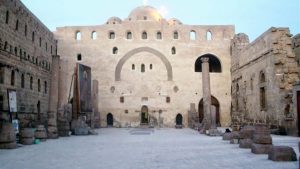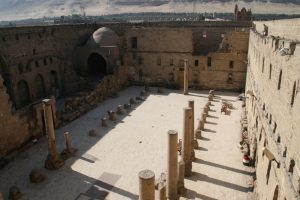 Deir el-Abyad (or the White Monastery in English) (also known as Deir Amba Shenuda or Shenute) is a Coptic Orthodox monastery. It lies about 4 kilometers south-east of the Red Monastery, some 15mi/25km north-northwest of Sohag (Suhag). It was named after Saint Shenouda (Shenute) the Archimandrite who founded it about 332/350 to 451/466. By the time of Shenouda's death, in 466 AD, the population of the White Monastery increased from 30 to more than 2000 monks and 2000 nuns. Although it was burnt at the Persian Conquest (619 AD), the church enclosed inside the monastery is still extant in place. After the Arab Conquest, the monastery began to decline and in 1168. The Monastery was restored during the 13th century, but it began to decline again since the 14th century, until it was burnt by the Mamelukes in 1798, while they were fleeing from Napoleon's army. During the reign of Mohamed Ali, part of the monastery was restored. The Last restoration was committed in 1980. The monastery's architecture is similar to that of the Red Monastery. It is one of the most celebrated and important monasteries in Egypt. Surrounding the monastery is a high wall of white limestone blocks. The church can be entered via a narthex that has an apse at the west end. Noticeably, it is an aisled basilica with a trilobate sanctuary, consisting of a square domed central area and three apses with semi domes. The apses have two rows of five niches alternating with columns. At the north end, there is a second narthex with a pillared apse.
Deir el-Abyad (or the White Monastery in English) (also known as Deir Amba Shenuda or Shenute) is a Coptic Orthodox monastery. It lies about 4 kilometers south-east of the Red Monastery, some 15mi/25km north-northwest of Sohag (Suhag). It was named after Saint Shenouda (Shenute) the Archimandrite who founded it about 332/350 to 451/466. By the time of Shenouda's death, in 466 AD, the population of the White Monastery increased from 30 to more than 2000 monks and 2000 nuns. Although it was burnt at the Persian Conquest (619 AD), the church enclosed inside the monastery is still extant in place. After the Arab Conquest, the monastery began to decline and in 1168. The Monastery was restored during the 13th century, but it began to decline again since the 14th century, until it was burnt by the Mamelukes in 1798, while they were fleeing from Napoleon's army. During the reign of Mohamed Ali, part of the monastery was restored. The Last restoration was committed in 1980. The monastery's architecture is similar to that of the Red Monastery. It is one of the most celebrated and important monasteries in Egypt. Surrounding the monastery is a high wall of white limestone blocks. The church can be entered via a narthex that has an apse at the west end. Noticeably, it is an aisled basilica with a trilobate sanctuary, consisting of a square domed central area and three apses with semi domes. The apses have two rows of five niches alternating with columns. At the north end, there is a second narthex with a pillared apse.
The Church of the White Monastery

Built in the Basilica style with six entrances, the Church of the White Monastery is the only surviving part of the original monastery. Its outer appearance has some similarity with Ancient Egyptian Temples, with its open courtyard of 52 meters long and 23 meters wide. Today, The current church occupies what used to be the choir and the sanctuary areas. The altar is located within the central or eastern apse. There is also a new wooden iconstasis adorned by small icons on its top register. The current sanctuary in the central apse is divided into three. The middle one is dedicated to Saint Shenouda the Archimandrite, the southern to the Virgin Mary, and the northern to Saint George.
